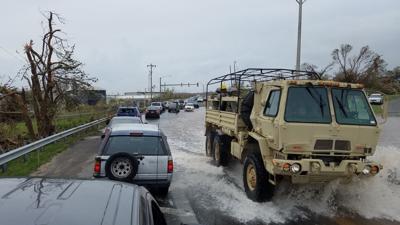ST. CROIX — Hurricane Maria’s eye may not have just missed St. Croix — by a scant 10 miles — but the Category 5 storm left its mark almost everywhere on the island.
Howling winds began about 10 p.m. Tuesday night — four hours after a government-ordered curfew set in — and did not retreat until after dawn.
The worst of the storm had passed by about 9 a.m., although gusts of strong wind continued throughout most of Wednesday.
Weather stations at Sandy Point National Wildlife Refuge and Cotton Valley — on the west end of the island, where Maria did the most damage as it passed through — reported sustained winds of 99 to 104 mph with gusts of 137 mph.
Everywhere The Daily News went on Wednesday, the most common question was how did Maria compare with Irma, whose eyewall raked St. Thomas and St. John on Sept. 6.
Cell phone service stayed active on St. Croix throughout Maria’s passing, and Luis Hospital remained intact and operational. Cell service on St. Thomas still remains sporadic and patchy and all of the patients have been evacuated from Schneider Hospital, which officials are saying is unusable and could require being rebuilt.
On in the southwestern end of Frederiksted, the hotel nearest the storm was expecting to salvage the tourism season.
“Wooden structures on the second floor on the water, and it’s amazing they weren’t more damaged,” said Paul Benedict, the business owner of Cottages by the Sea. He was able to get sandbags at the cracks in the doors.
One building at the hotel was rebuilt following Hurricane Hugo, but it survived Maria with only minimal damage.
“I’m glad the eye didn’t hit us,” Benedict said.
But across St. Croix, Maria left destruction and debris in its wake, and there was ample evidence of its furious winds and torrential rains.
The sun rose Wednesday morning on felled trees and power poles that frequently made roads impassable.
And the storm chose its victims at random.
Well-to-do neighborhoods in the southern section of mid-island appeared nearly unscathed, while densely populated areas in and around Frederiksted were heavily damaged.
The University of the Virgin Islands Research and Technology Park building was almost totally destroyed.
However, Gillian Marcelle, the RT Park’s director, was upbeat. She hadn’t yet made a trip to the central campus — the road leading from Centerline Road into the denser areas of the campus was made impassable by fallen royal palms — and her building was only one component of the complex.
“This is the opportunity to do it right,” she said, “To make use of technologies that are affordable, cleaner, more environmentally friendly.”
Others weren’t so lucky.
A woman outside the government-run shelter at St. Croix Educational Complex High school said she’d been left completely homeless and didn’t want to talk about it.
About 300 people took refuge at Complex during the storm, said Donna Pickard, a V.I. Human Services Department employee who was managing the shelter. Their number included a few amputees, who typically would have been put in the special needs shelter at the Harwood complex, though Pickard wasn’t sure why they’d been brought there.
“Not right now,” she said about whether the shelter is getting everything it needs for the people staying there. “The Red Cross is really dropping the ball.”
V.I. Police Officer Erik Jefferson interrupted the interview to ask whether he could bring a full carton of water packets to a family that was trapped. Three people were trapped in a house, alive and uninjured, and they had asked Jefferson to bring them water.
“Take two,” Pickard said. “Anything for the VIPD.”
Jefferson said he was on his way home about 7 p.m. Tuesday night at the end of his shift when an off-duty officer called for assistance. Jefferson said he went over to help, but the storm got so bad, he was forced to shelter with the other officer.
Jefferson was on St. Thomas for Irma, and he said the response on St. Croix is different.
“This is way better than on St. Thomas,” he said.
At the north end of Frederiksted, a few pedestrians gathered to watch wind-blown surf pour over what used to be the southern edge of Rainbow Beach. The curfew couldn’t prevent a few people, such as Surria Augustin, gathered to marvel at the waves crashing from the swollen surf.
“The water it gets high,” she said. “Like high tide.”
Augustin rode out the storm in William’s Delight.
“In my yard, we have a lot of trees down,” she said.
Her neighbor’s house was without a roof, and she said the storm may have proved to be too much for many people who called St. Croix home.
“A lot of other people talking about leaving, but I, honestly, I don’t know,” she said. “I think I’m going to stay, and St. Croix will just build back.”
— Contact Brian O’Connor at 340-714-9130 or email boconnor@dailynews.vi.

